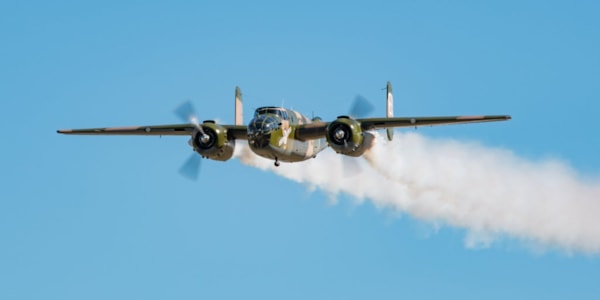B-25 returns to the sky

The EAA is taking another iconic WWII bomber on a tour across the U.S. this summer. The North American B-25 Mitchell Berlin Express has been fully restored and is ready to return to the sky.
The tour will begin in Madison, Wisconsin from June 2-4 and other stops include Terre Haute, Indiana from June 16-18 and Ankeny, Iowa from July 14-16. More stops will be added to the schedule once they have been finalized. The aircraft will also be on display for the entire week of EAA AirVenture. The attendees at AirVenture can view the show from the skies in the restored Warbird.
Tickets for the Berlin Express are $425 for adult EAA members and $475 for adult nonmembers. Passengers can freely roam about the aircraft during the one-hour flight, which includes a briefing, debriefing and 18 minutes of flight time.
The B-25 was a medium bomber that served in WWII. The twin-engine and twin-tailed plane was used by all three branches of the U.S. Armed Forces. The plane was able to carry a bomb load of 2,400 for 1,200 miles at a speed of 300 mph.
The B-25 was combat-ready in early 1942 and used throughout the war. By the end of the war, nearly 10,000 B-25s had been built. After the war was over, the warbird continued to serve in peacetime for personal transports and as training aircraft. The last B-25 was retired from service in May 1960.

The Berlin Express, number 98-21433 and serial number 43-4432 was accepted by the U.S. Army Air Forces in December 1943. The H model had a blunt and solid nose, fitted with two fixed .50-caliber machine guns and a large 75mm cannon. These are similar to the main gun used on many models of the Sherman tank. The 327th H model served in an administrative aircraft role, stationed at bases in Washington, California and Colorado. At one point, the plane was modified to use as a trainer.
The plane was sold as surplus after the war and moved around often over the next two decades. It was owned by Woolworth’s heiress Barbara Hutton for a time and in 1968 it was selected to be a star. Tallmantz Aviation thought the plane was meant for the movies and it was given a nose job, with a J-model greenhouse nose section. The change was to give it a more classic B-25 look before its first role.

EAA’s B-25, Berlin Express, flies over open water. (EAA photo/ Connor Madison)
It was in a group of 17 other flyable B-25s on the production of Catch-22. The plane had a role as the VIP transport for Brig. Gen. Dreedle, Orson Welles. The group of B-25s logged over 1,500 hours of flight during the shoot. After the movie, the plane was sold to a Warbird collector and accomplished air race pilot from Merced, California. After his death, the plane was donated to the EAA Aviation Foundation.
EAA staff and volunteers restored the plane starting in 1975, removing its Hollywood glamour and repainting it with nose art to honor EAA’s home state, Wisconsin. It was damaged after a gear failure on landing after several years of flying with the EAA. It underwent a cosmetic restoration and was moved into the EAA Aviation Museum’s Eagle Hangar and was on display for a few decades.

EAA’s B-25, Berlin Express, lifts off the runway at Wittman Regional Airport in Oshkosh, Wisconsin. (EAA photo/Connor Madison)
The plane has been restored to its red-carpet ready look, and the movie markings when it flew as the Berlin Express. It will join the B-17 Aluminum Overcast to honor WWII veterans and inspire future aviators.
Contact
Name: Haley Davoren
, Digital Content Manager
Company: GlobalAir.com
Website: https://globalair.com
Email: [email protected]
Phone: 502-456-3934
©2023 GlobalAir.com, Haley Davoren. All rights reserved.

Recent Comments